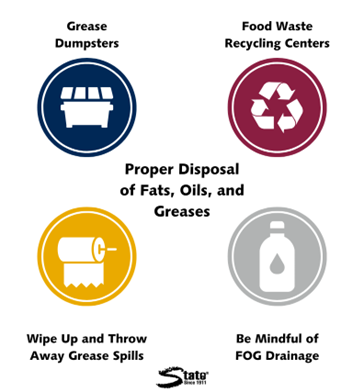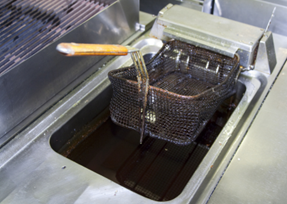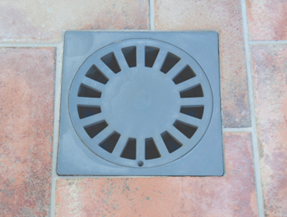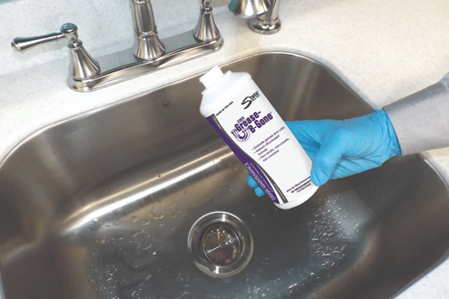How to Dispose of Fat, Oil, and Grease (FOG)
How to Dispose of Fat, Oil, and Grease (FOG)
Picture this: you’re the manager of a local ice cream parlor. It’s a popular place in town, and by the end of the day, there is a mountain of dishes in the sink—full of melted ice cream. Of course, in the rush to go home, your staff dumps the melted ice cream down the drain and then washes out the containers. It has gone on like this for years.
For your business, slow drains and drain clogs happen all the time. They’re a regular headache for you to deal with, fielding customer complaints whenever the sink overflows and service slows down. But this is starting to become exhausting, and you know it isn’t sustainable. Instead, you want to learn how to properly dispose of fats, oils, and greases (FOGs).
State Chemical provides chemical solutions to various problems, including slow drains, drain clogs, and drain odors. We know that FOGs can cause costly damage to your facility; our goal is to provide you with accurate information so that you can avoid this outcome.
To accomplish this goal, we will explain what FOGs are, how to control what goes down your drain, proper FOG disposal, and further preventative maintenance. After reading, you’ll know how to dispose of FOGs in your facility and better care for your drains.
What are Fats, Oils, and Greases?
When we say FOGs, we’re referring to any fatty, oily, or greasy substance that might be found in your facility. This can include butter, cooking oil, soup, peanut butter, ice cream, and salad dressing.
So, what happens when FOGs go down your drain? The effects won’t be instantaneous. If you dump mayonnaise down your drain one time, it won’t back up the whole system. However, if this becomes a continuous theme over time, you could be looking at drain backups.
Let’s say you pour frying oil down your sink every week. It’s a liquid when it enters the drain, but when the oil cools, it hardens. Think about when you leave a frying pan out to cool, and the grease solidifies within just a few minutes. Now, imagine large quantities of hardened oil clinging to the insides of your pipes.
Like a clogged artery, the usable diameter of your pipes will slowly get smaller and smaller. Once it gets small enough, it’ll take longer for liquid to get through to the other side, so your sink will take longer to drain. Eventually, a four-inch-wide pipe might have a pinhole of usable space, and you’ll be dealing with a clog.
Control What Goes Down Your Drain
No one wants to deal with this, so your best first step is to pay attention to what’s going down your drain right now.
Are you dumping frying oil or grease? Do you wash down food scraps? How about milk, gravy, meat trimmings, or sour cream?
More items are considered FOGs than the traditional bacon grease you might think of, making it difficult to know what is and isn’t safe. Generally, a good rule of thumb is that any non-greasy and non-absorbent food won’t cause clogs. If it’s easy to chew and broken up into smaller pieces, it can usually clear your pipes. If it doesn’t meet these criteria, you’ll want to find a different disposal method.
Disposing of Fats, Oils, and Greases
So, how should you dispose of FOGs if not down your drain? Here are some methods to keep in mind:
Use Disposal Containers or Grease Dumpsters
The most common method of FOG disposal is via disposal containers. In a restaurant kitchen, for example, there might be a designated disposal container behind the restaurant. This is a place where your staff can dispose of FOGs daily by scraping hardened FOGs into it.
The downside of disposal containers is that they start to smell bad as they collect FOGs, and grease can leak out and cause environmental harm if they crack open.
Work with Food Waste Recycling Centers
You can prevent these issues by conducting regularly scheduled grease pickups with a cooking oil collection company. In this situation, you’ll still use a grease dumpster, but there will be a consistent schedule for when the company comes to collect the discarded FOGs, usually weekly or monthly, depending on the size of your business.
When the company comes, they will use a vacuum truck to suck out the waste, and it will then be recycled into renewable fuel.
Wipe Up and Throw Away Grease Spills
Another way to properly dispose of FOGs is by cleaning up spills. For example, let’s say that you spill grease on the floor while cooking. It may be tempting to just deal with it when you mop, but this will mean pushing FOGs into your floor drains. Over time, your floor drains will then see FOG buildup and slow drains.
To avoid this, soak up spilled FOGs with a paper towel and throw the paper towel away. It may be tedious, but it’ll save you trouble down the line (that is, the drain line).
Be Careful About What Enters the Garbage Disposal and Dishwasher
It’s also important to pay attention to what you put in your garbage disposal and dishwasher.
If you have a garbage disposal, it’s easy to just assume it’ll handle whatever you put down. But because of this mindset, it’s especially important to be wary of what you put in your garbage disposal.
Yes, a garbage disposal can break down greasy food, but greasy food will congeal further down the pipes and cause backed-up drains. Garbage disposal or no garbage disposal, this will negatively impact your business.
Additionally, it’s important to remember that every food scrap that goes through your dishwasher will go down the drain too. So, putting a greasy pan in the dishwasher rather than the sink does not save your drains any trouble. That grease will go down the pipes just as it would in the sink, and it’ll build up.
Be mindful of what goes down your garbage disposal, dishwasher, and other non-traditional drains; your facility will feel the impact.
Preventative Drain Maintenance to Further Protect Your Pipes
In an ideal world, none of these items would go down your drains, but realistically, that’s not going to happen. Even when you wash your hands, you’re putting body oil down the drain—complete avoidance just isn’t feasible.
On top of being wary about what goes down your drains, it’s a good idea to consider preventative maintenance. Chemical maintainers break down buildup in drains, which in turn prevents slow drains, clogs, and odors.
Always pay attention to what enters your drain and find a way to properly dispose of FOGs, but since you can’t control everything, chemical maintenance can provide powerful peace of mind.
Your Next Step: Consider the Pros and Cons of Preventative Drain Maintenance
It’s stressful to deal with drain problems, but it’s also difficult to figure out where to drain FOGs instead. Now that you know proper ways to dispose of FOGs in your facility, further consider how to care for your pipes by learning the pros and cons of preventative drain maintenance.












